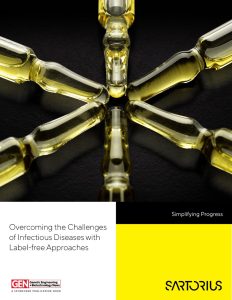In response to the global COVID-19 pandemic, vaccine research and manufacturing processes have seen unprecedented advancements over a short timeframe. While the worldwide attention to public health has put the spotlight on the multi-step process of vaccine development, adapting our platforms to meet the growing global demand for life-saving vaccines has always been top-of-mind for infectious disease researchers.
Sartorius supports scientists throughout every step of the vaccine development process—from analysis of virus biology, infection mechanisms, host responses, and deter-mining therapeutic mechanisms, to candidate selection, pre-clinical and clinical assessment, and regulatory approval for use in humans. High-throughput label-free technologies, like the Octet® Bio-Layer Interferometry (BLI) systems are accelerating the selection of antigenic targets by enabling kinetic interaction analysis in real-time.
Traditional methods for analyzing biomolecular interactions such as ELISA provide only end-point data without taking into consideration the association and dissociation kinetics. Furthermore, they are often cumbersome and may require time-consuming sample preparation. When the world’s attention is on rapid development of viable vaccine and therapeutic candidates, fast and flexible solutions become indispensable. The fluidic-free design of the Octet® BLI platform combined with a wide variety of off-the-shelf dip-and-read biosensors play a critical role in determining vaccine potency, stability, and titer measurements in upstream and downstream vaccine and biotherapeutic development and manufacturing.
This eBook explores the latest methodologies and suggests alternative strategies in the development of future vaccines to fight the huge variety of infectious diseases. The first article reports a new type of cholera vaccine, consisting of polysaccharides displayed on virus-like particles. Tested in mice, the new vaccine was found to generate long-lasting antibody responses against the causative bacterium, Vibrio cholera. The second selection highlights the latest in immunotherapy approaches, such as mRNA vaccines, monoclonal antibodies (mAbs), and designer DNA vaccines, targeting infectious diseases. The third article reviews the findings of a study showing broad-spectrum activity of two human antibodies against Ebolaviruses. The fourth article summarizes structural data on the attachment glycoprotein of a Henipavirus, Nipah virus, in complex with an antibody fragment, informing new therapeutic strategies for tackling these deadly infections. The final article looks at how primary infection with a pathogen affects our immune response to a secondary infection with SARS-CoV-2.
Sponsored by:


